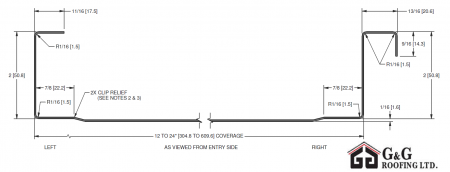Materials:(G&G) New Tech Machinery SSQ II
Materials:(G&G) New Tech Machinery SSQ II
Division C - Accepted Materials
New Tech Machinery SSQ II
by G&G Roofing Ltd.
| The metal panel listed and described below is accepted for use in the RoofStar Guarantee Program. |
The roofing assembly / material information published below and in the RCABC Roofing Practices Manual DOES NOT represent a complete set of the manufacturer's published data, nor does it represent a detailed specification. The preparation of a detailed specification is the responsibility of the design authority. For more information about this product or system, consult the manufacturer. |
OVERVIEW
The New Tech SSQ II standing seam panel is formed with an on-site/in shop continuous metal roofing panel roll forming machine (New Tech Machinery SSQ2U). This machine produces a standing seam panel with a seam height of 38 mm (1-1/2") or 50.8 mm (2") and profiles can vary from 304.8 mm (12") wide up to 508 mm (20") wide.
On-site roll forming provides for the elimination of end laps with continuous panel forming capabilities in lengths up to 300'.
SYSTEM DESCRIPTION
- General: The New Tech SSQ II standing seam panel is secured with concealed fastener. The maximum spacing of screws in the built in 'nailing strip' is 635mm (24")
- Range of application: Installed on wood or steel sloped roofs, in commercial, institutional, industrial and residential construction. For re-roofing or new construction. Note that panels with a 'nailing strip' are restricted in their length (Ref. Standard for Architectural Sheet Metal (ASM) Roof Systems, Article 9.2.1.1., Sentence (6).
- Panel Attachment: Fastening is site specific, engineer must confirm fixing specifications.
- Fasteners (Screws):
- Fasteners used to attach panel clips to steel must be specified by the registered engineering professional but are usually No. 10-16 by 25 mm (1") long self-drilling, self-tapping pancake head plates steel screws. Use two fasteners per panel clip, inserted into panel clip guide holes, or as otherwise specified by the registered engineering professional.
- Fasteners used to attach panel clips to plywood must be specified by the registered engineering professional but are usually No. 10-16 by 25 mm (1") long pancake head plated steel screws for wood. Use two fasteners per clip, inserted into panel guide holes, or as otherwise specified by the registered engineering professional.
- Panel Clips: One piece assembly manufactured by New Tech Machinery (or approved equal). Minimum thickness 0.022 in. (No. 22 MSG). Clips spaced maximum 600 mm (24") O.C., or as specified on engineered shop drawings (Ref. Standard for Architectural Sheet Metal (ASM) Roof Systems, Article 3.1.3.3. and Article 3.1.3.5.).
- Deck Requirements: in keeping with the Standard for Architectural Sheet Metal (ASM) Systems.
PROFILES
TECHNICAL DATA SHEET
Click below for the Technical Data Sheet
SITE CONDITIONS
Minimum roof slope is 1:6 (2" in 12"). Severe conditions (heavy snow or ice) minimum slope is 1:1.5 (8" in 12").
PERFORMANCE REQUIREMENTS
- Wind Uplift Resistance: Panel securement shall conform to the requirements in Part 3 of the Standard for Architectural Sheet Metal (ASM) Systems.
- Materials:RoofStar (RGC) accepted metal panel systems shall be formed of steel conforming to the requirements published in Section 9.2. of the Standard.




